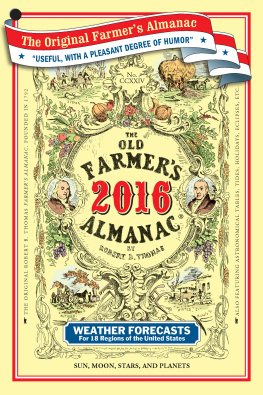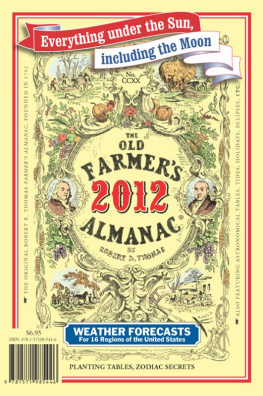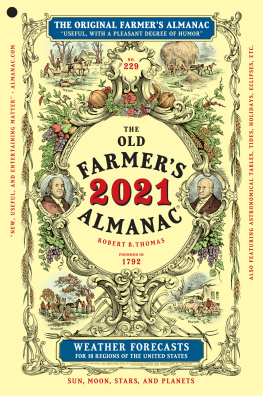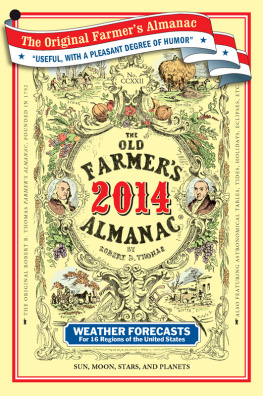To Patrons
Weather Proof
Readers consistently tell us that weather is the #1 reason they read this Almanac. It has been this way for centuries, possibly due in part to a weather forecast that we made (or maybe didn't make) 200 years ago.
Nobody expected what actually happened.
Snow fell during July and August of 1816 in New England and parts of Canada.
The diary of Rev. Thomas Robbins of East Windsor, Connecticut, tells of a foot of snow in the Berkshires in June.
In July, heavy frosts and ice storms occurred. On the 4th, Caleb Emery of Lyman, New Hampshire, visited a well that was completely frozen over 8 feet belowground; it remained that way until July 25.
The region's corn crop, except where near ponds or the ocean, failed.
So many birds froze that few were seen in New England for 3 years.
In the history books, the period is referred to as the year without a summer and the cold summer of 1816. Its cause was eventually shown to have been an 1815 volcanic eruption of Mount Tambora in what was then the Dutch East Indies. This event had left volcanic dust circling the globe, lowering temperatures as much as several degrees and resulting in snow. Such an eruption would explain the appearance of the Sun in 1816 as in a cloud of smoke, as described in the American Magazine of History.
But did the Almanac predict this weather? We still get questions about this, and we've had an eye out for copies of that 1816 edition. Several have been found, but none has a snow prediction for that summer.
As the story goes, the printer inserted a snow prediction into the 1816 edition as a joke while Almanac founder Robert B. Thomas was sick in bed with the flu. When Thomas discovered the error, he destroyed allor maybe most ofthe snow copies and had the 1816 Almanac reprinted with the more conventional forecast. It's said that word got out anyway, and during the early months of that year, Thomas repeatedly had to deny making such a ridiculous forecast. Then, when it really did snow in July, he changed his tune and took full credit. Told you so! he allegedly said.
If the story is true, it's a good example of what this Almanac's 11th editor, Robb Sagendorph, always referred to as almanacsmanship. Today, our meteorologist, not the printer, makes the weather predictions. Almanacsmanship goes into all of the other pages.
J. S., June 2015
However, it is by our works and not our words that we would be judged. These, we hope, will sustain us in the humble though proud station we have so long held in the name of
Your obedient servant,

2016 Trends

ON THE FARM
Healthy soils are a key advantage for farmers dealing with increasingly unpredictable weather. The better they manage the soil, the less they need to spend on fertilizers, pesticides, and fuel.
Helen Husher, spokesperson, Northeast Sustainable Agriculture Research and Education
COMING SOON
- robot bees that pollinate crops
- audio pest control: Plants hear the man-made sound of insects chewing vibrations and release chemicals to protect themselves.
- drones to detect where crops may need replanting or pesticide application
- plants with leaves that grow at an angle: They absorb less sunlight and offset climate change.
HIGH TECH, HERE NOW
- DNA analysis to help ranchers learn which cattle will produce large numbers of the tastiest steaks
- nutrient-dense varieties of veggies (data suggest that plants will become less nutritious with rising CO2 levels)
- light, electric, four-wheel vehicles to help farmers carry a ton of cargo
FORWARD-THINKING FARMERS ARE...
- using no-till cover crops and diverse rotations to improve soil quality and control erosion
- converting abandoned urban factories into state-of-the-art greenhouses
- connecting with grocery shoppers by doing in-store cooking demos
BY THE NUMBERS
42% of organic farms sell directly to consumers (compared to 7% of all U.S. farms)
2,398: number of greenhouse acres now in production in Ontario
17.3 million: number of Christmas trees harvested annually
GOOD EATS
Specialty food stores and supermarkets are becoming the new community centers.
Denise Purcell, senior director, Specialty Food Association
PEOPLE ARE TALKING ABOUT ...
- airline food delivered to the home
- frozen yogurt in edible dried-fruit wrappers (to reduce packaging waste)
- smaller portions (for better health)
- butter tastings as appetizers, to sample flavors and types
EATING IS MORE SOCIAL: WE'RE...
- meeting and dining at food halls (not courts)
Darcy Lenz, assistant food editor, Cooking Light - sitting at communal tables for face-to-face interaction
- sharing tastes from companions' plates
WORD FOR THE WISE
Grocerant:
a place that serves as both grocery and restaurant
BY THE NUMBERS
12% of Americans eat dessert after supper
1,128: number of snacks the average adult eats each year
91% of us snack daily
205: number of weekday breakfasts eaten at home per person per year, on average, as this becomes the family meal
FLAVORS WE'RE CRAVING
- smoke in butter, vegetables, and cocktails
- heritage breeds of chicken (firmer and stronger-flavored)
APP-SOLUTELY APPETIZING!
Restaurants want to give diners reason to post photos of meals on social media: Look for architectonic creations on plates that beg to be photographed and shared. Chefs are realizing that the look of food is as important as taste.
Daniel Levine, director, The Avant-Guide Institute
GARDENING
People are seeing public parks, botanical gardens, and arboreta as the cultural hearts of their citiesplaces for serenity, learning, and great local food.
Casey Sclar, executive director, American Public Gardens Association
PEOPLE ARE TALKING ABOUT...
- tablescaping, with pansy and petunia center-pieces and candelabras
- planting new, adaptable tree varieties
- Tamarixia radiata, natural predator of the yellow dragon fly that is ravaging orange groves in Florida and southern California
- small, lightweight, greenhouse community gardens in vacant urban areas
- backyard pub-sheds
APP-SOLUTELY AMAZING!
- apps that alert when fruit and veggies are ripe
- Internet-connected indoor hydroponic crops tracked remotely by growers
SPACE-SAVERS
- Park Seeds picks: Mega Bite tomatoes, Spacemaster 80 cukes, Norli snow peas, Bull Dog okra
HARDWORKING PLANTS
- multipellet seeds that produce several varieties of plants
- EnduraScape, a new verbena that tolerates temperatures from the teens to more than 100F
- mildew-resistant impatiens and basil
BY THE NUMBERS
42 million: number of U.S. households that grow food in a home or community garden
3 million: number of community gardens in the United States














